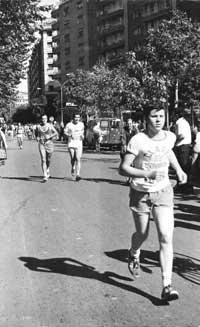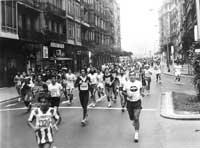MARATHON: the most popular race
But well, the Marathon (XIX) that is held in Donostia within a few days has given me the excuse to prepare this little work today and will forgive me that the longest test of all races is the axis of my activity. The San Sebastian Marathon is one of the many races of this kind that are held all over the world, although it has its own characteristics (you will hardly find a better place to run! ).
Attendees know perfectly well that the mere completion of the test has sufficient merits. This fight against the stopwatch is a very hard task, and the mere fact of ending means winning by reaching the goal, as for the first, for the rest.

As well know those who practice the marathon today, to enjoy (if it is possible to say) is essential a good preparation. A visit to a sports medicine specialist is almost mandatory before starting an effort of this measure. The doctor, in addition to evaluating the general state of health, will give us advice on the average heart rhythm of the first workouts and the limit of beats that the heart can suffer in its maximum effort.
In addition, it should not be forgotten that the realization of a career of this level also directly affects life: tobacco and alcohol are prohibited, of course, and should rest between six and eight hours a day. Nutrition does not have to be special, at least for a non-leading runner, but it is recommended to introduce in the food little amount of refined carbohydrates, fruits, vegetables, fiber and water, avoiding as much as possible fats, sweets and carbonated drinks.
First steps in preparation
The first nuances are usually special but very important. Don't worry if you only do a couple of miles. If the body is fine, you will be able to accumulate kilometers, even if slowly, until you get the necessary resistance to finish the marathon. From there, each will seek the rhythm of their progression based on their sports fitness, age and type of muscle fibers.
It is advisable to start as soon as possible to accumulate kilometers. Almost without realizing it, after a few months of training and having traveled at least 500 kilometers (you have already broken some shoes), you will be ready to collect the fruits of the sowing. It's time to be calm. If you've come here, everything goes well. And don't forget that trusting to finish the race is essential to be able to face the test.
The workouts of the last week will be carried out following the planned march, without last minute “exploits”. They should not be too hard, but long sessions, reaching about 20 kilometers to five days before the test. From there, the most prudent thing is to take care of the muscle, jogging for two or three days for an hour or an hour and a half. During the last seven days the diet will be something special, rich in unrefined carbohydrates (macaroni, spaghetti, etc. ). ).
On the other hand, you also have to look good at clothes and, of course, shoes are the most important. As is known, racing is not the ideal time to experiment, so premiering shoes that day is a mistake. You must know well the shoes before the race, they will be stable (lightness will be considered as a secondary feature), without noticing that they adapt or adapt well to the foot and without spending the sole, so that no blisters occur. One tip is that between the tip of the thumb of the foot and the shoe there is a space of half a centimeter.
And of course, during training, every two weeks or for example, you should clean the shoes so that you do not miss the flexibility and remove the sweat that accumulates. And after worrying about shoes, you'll also pay attention to clothes. The socks, pants and t-shirt will be light colors, white to choose from, and natural fabric like cotton. As for the socks, choose those who do not have seam, because when you have to travel so many kilometers, what seems a nonsense can even end the race.
The day comes

It is recommended to rest two days before the race, usually on Friday, as Saturday night will be a little nervous. Saturday, or race eve, leads a quiet life to prevent a peak of accident that expounds all the efforts made so far. At evening dinner you eat pasta as at noon, but to the extent necessary to rest properly.
The race day arrives. Three hours before the marathon, stand up! A shower, not the bathroom, to “wake up” the body, to start putting it in tone and to have breakfast. Neither sugar nor milk can be indicated and (in any case, personal experience is more valuable than general advice, that is, those already tested). Juices, coffee, fruit and cereals are appropriate to start the day. From now on and until you hear the exit order, you will catch water in small tricks so you do not thirst. And beware of sweets, which are the main responsible for the dreaded feeling of bad wind or “calm”.
Being at the point of race, rub well with the vaseline the armpits, the inner part of the thighs, breasts and fingers, especially if it is hot, thus avoiding the slags. As for warming, you will do it based on the experience you have, at your own pace. However, before starting the race it is necessary to pull certain muscles, inside or outside the warm-up exercises.
Well, you're ready to start. Before leaving, orient, watch out for adrenaline, as excessive euphoria can cause more damage than benefits. Start slowly, at a relatively slow pace, slightly reducing the strides; note that it is better to make the second part of the race faster than the first. The actual difficulty of the test starts approximately from kilometer 25. Drink the water and liquids that the organization will offer in different areas, because they will come well to prevent dehydration and cramps.
And from there you will have to put in your work the reader, your strength, your mind and your ability. Luck and congratulations in advance!
Buletina
Bidali zure helbide elektronikoa eta jaso asteroko buletina zure sarrera-ontzian











